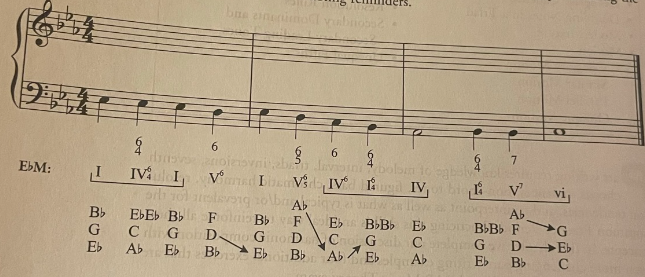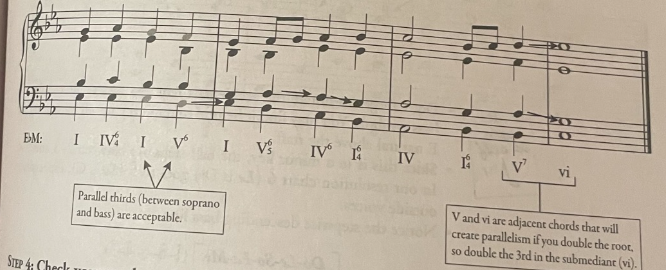
Chapter 14 - Harmonic Composition 2: The Process
Part-writing requires knowledge of melody, interval, triads, inversions, seventh chords, cadences, non-chord tones, figured bass, chromatic harmony, resolution tendencies, and counterpoint.
Part-Writing and Figured Bass Examples
Figured Bass in Eb Major
This example uses three-second inversion triads and introduces the submediant triad (vi) and the deceptive cadence.

Add the Roman numeral chord symbols and inversions.

Write the melody

Fill in the alto and tenor at the same time

Check your work
Correct chord members
Resolutions (including holding the chordal seventh on Ab until it can resolve to G)
Double the fifth in 6/4 chords
No parallel fifths or eights
Spacing
Scoring
Common errors and how to avoid them
Omitting the accidental
Spelling the chord incorrectly (not putting the sharp sign)
Omitting the root
Parallel fifths between the bass and tenor
When V7 goes to I or i, if the V7 has all four members, then the tonic chord will have three roots, one third, and no fifth.
If the V7 is not complete, then that will lead you to a complete tonic triad.
Leading-tone chords will have three resolution tones.
Chapter 14 - Harmonic Composition 2: The Process
Part-writing requires knowledge of melody, interval, triads, inversions, seventh chords, cadences, non-chord tones, figured bass, chromatic harmony, resolution tendencies, and counterpoint.
Part-Writing and Figured Bass Examples
Figured Bass in Eb Major
This example uses three-second inversion triads and introduces the submediant triad (vi) and the deceptive cadence.

Add the Roman numeral chord symbols and inversions.

Write the melody

Fill in the alto and tenor at the same time

Check your work
Correct chord members
Resolutions (including holding the chordal seventh on Ab until it can resolve to G)
Double the fifth in 6/4 chords
No parallel fifths or eights
Spacing
Scoring
Common errors and how to avoid them
Omitting the accidental
Spelling the chord incorrectly (not putting the sharp sign)
Omitting the root
Parallel fifths between the bass and tenor
When V7 goes to I or i, if the V7 has all four members, then the tonic chord will have three roots, one third, and no fifth.
If the V7 is not complete, then that will lead you to a complete tonic triad.
Leading-tone chords will have three resolution tones.
 Knowt
Knowt